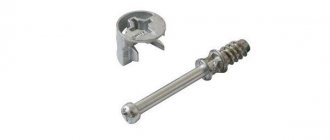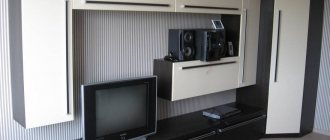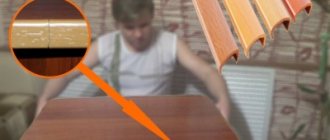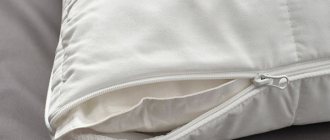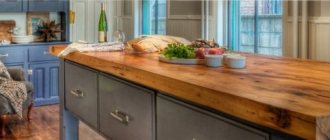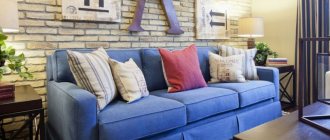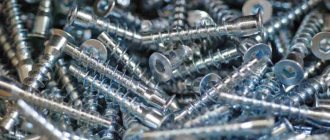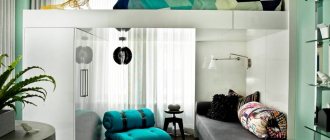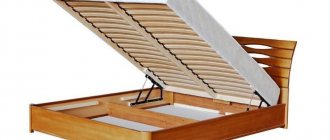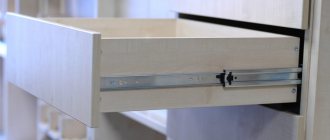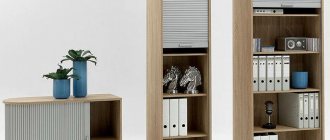Purpose
Furniture edge is a narrow strip of edging around the edges of furniture, which serves to protect them from mechanical damage. It also plays the role of a decorative element. If the furniture is made of chipboard, then the PVC edge will prevent the emission of formaldehyde.
| Correspondence table for standard sizes and weights of edges | |||||
| Thickness mm | Width mm | Number of bays | Bay m.p. | Box m.p. | Box weight kg. |
| 0,45 | 19 | 10 | 200 | 2000 | 24 |
| 0,45 | 22 | 10 | 200 | 2000 | 28 |
| 0,45 | 26 | 5 | 200 | 1000 | 19 |
| 0,45 | 30 | 5 | 200 | 1000 | 21 |
| 0,45 | 41 | 5 | 200 | 1000 | 29 |
| 0,45 | 55 | 5 | 200 | 1000 | 36 |
| 0,8 | 19 | 5 | 200 | 1000 | 24 |
| 1 | 19 | 5 | 200 | 1000 | 30 |
| 1 | 22 | 5 | 200 | 1000 | 34 |
| 1 | 26 | 5 | 200 | 1000 | 40 |
| 1,8 | 19 | 5 | 100 | 500 | 27 |
| 1,8 | 22 | 5 | 100 | 500 | 31 |
| 1,8 | 26 | 5 | 100 | 500 | 36 |
| 1,8 | 30 | 5 | 100 | 500 | 41 |
| 1,8 | 35 | 3 | 100 | 300 | 33 |
PVC edge color: choice of texture and shades
The manufacture of furniture from laminated chipboard requires the selection of PVC edges for processing the end sides of its parts.
The level of fusion between the color of the edge and the board used, taking into account the requirements of the modern consumer, should be high, both for expensive and economical furniture.
This situation is justified, since the decor of the tape itself does not increase its cost in any way depending on how it fits the slab, and the expensive and cheap edges should have maximum similarity to the shade of the chipboard.
It is no secret that consumers do not always know how the end parts of laminated chipboard furniture are processed, that there is an edge, but when choosing furniture, they are attentive to details and often intuitively they prefer furniture where a 25 mm thick board is used, the parts are processed with a 2 mm edge and the higher the visual fusion of the ends of the furniture to its main color, the more often it is chosen.
Let's consider the main indicators of the visual merging of the decor of the edges and the slab, which buyers most often do not see, but are taken into account by manufacturers to increase sales.
- Base color
- Edge color
- Texture
- Embossing
- Edge gloss/matte level.
Schematically, the edge decor looks like this (Figure 1):
Figure 1: Color structure of PVC edge tape.
1. Base color (PVC color)
This parameter is especially important for edges with a thickness of 1 mm or more, because after removing the overhangs, the end of the edge must coincide with the decor of the slab, although this requirement is made quite often for thin strips.
It is important that the base on which color and texture will be applied in the future, if we are talking about wood shades, is in the same tone as the slab or matched to the tone of its light/dark areas.
Each manufacturer decides which shade is best suited individually.
When selecting solid colors, one is limited only to determining the base dyes, i.e. The selection of the color of the finished edge is carried out at the extrusion stage and is not further painted.
2. Edge color.
The first layer of paint when painting an edge is its fundamental one, which sets the tone for the future decor.
It is very important here, just as in the case of the base, to determine which area of the slab you need to select the color for.
Which area will be a priority is determined individually by each furniture maker.
It is quite common now to use dark-colored edges on a light-colored slab, or vice versa.
Quite an effective way to highlight details and add zest to the finished product.
3. Texture.
The variety of textures of slab manufacturers obliges edge suppliers to take it into account.
Even if the color of the edge matches two shades, and the texture is different, the quality of the visual perception of the furniture is reduced, for example, the background color of maple and milky oak are in a very similar tone for many board manufacturers, but the texture is completely different, so milky oak can be edged with maple Not many manufacturers can afford it.
An edge with the transverse texture of sawn wood looks very impressive; when using such an edge, a piece of furniture acquires a transverse cut.
4. Embossing.
The tone of the finished tape also depends on how the embossing is applied to the edge decor, especially when perceived from different light angles.
This is also an important parameter for achieving maximum visual merging of the edges and the slab.
Now, for example, factories producing laminated chipboards often make monochromatic decors with wood embossing, and with this use, edge embossing comes to the fore, since the smooth surface of the tape or the widely used shagreen embossing will not allow achieving the desired result.
5. Gloss level.
Depending on the gloss level of the selected board for future furniture, it is important to select an edge.
The surface can be highly glossy or completely matte.
From a physics point of view, the degree of gloss of a coating (surface) is the magnitude of the intensity of light scattering.
The more light is scattered, the more matte the surface appears.
To measure and determine the degree of gloss of paint and varnish coatings, the photoelectric method is used.
The device is called a “Gloss Meter” and its operating principle is quite simple. A beam of light is directed at the surface at an angle of 60°.
Some of the light is scattered, some is reflected at the same angle, hitting the photodetector.
Quantitative assessment of the degree of gloss is expressed in %.
For classification, the degree of gloss of the surface of edges and slabs is divided into groups:
| Shine group | Gloss level,% |
| High gloss | more than 80 |
| Glossy | 61-80 |
| Semi-gloss | 36-60 |
| Semi-matte | 11-35 |
| Matte | 6-10 |
| Deep matte | 0-5 |
Taking into account the above indicators, you can select the edge as close as possible to the slab you are using.
IMPORTANT! When visually selecting samples of edges and slabs, take into account the degree of lighting in the room; it is best to look in different rooms, on the street and on the light table.
The optimal distance for comparing shades is the distance of an outstretched arm; this is how the furniture buyer perceives the integrity of the furniture parts, and therefore the degree of visual fusion of the color of the chipboard and the edged ends.
If you are very demanding when choosing edge materials, then we are ready to select edge decor for you, taking into account the parameters agreed with you.
Send a request for technical specifications and find out the cost of edges.
In addition, more than 60 shades of PVC edges are always available ( in the catalog ) in a warehouse in Moscow, in a warehouse in Yekaterinburg, as well as in dealer stores throughout Russia.
Range of thicknesses 0.4 mm, 1 mm, 1.8 mm, 2 mm, grooved width or 19 mm, 25 mm, 28 mm, 35 mm.
Order your edging now. We look forward to collaborating. We value your time and will definitely complete your order on time.
Woody
PVC 1145 (Natural Sonoma Oak) PVC 3734 (Natural Dijon Walnut) PVC 026 D (Wenge) PVC 022 D (Wenge) PVC 079 D (Light Shimo Ash) PVC 014 D (Noche Eco Walnut) PVC 025 D (Bleached Oak) PVC 180407-4 (Chenon Oak) PVC 0065-2 (Fremont Oak) PVC 0065-1 (Grey Veralinga) PVC 0065-3 (Grey Edison Oak) PVC 0066-1 (French Mocha Oak) PVC 0068-4 (Mountain Larch) PVC 1704 (Grey Hungarian Oak) PVC 069 (Chocolate Oak) PVC 123 (Grey Oak) PVC 0073-2 (Red Hungarian Oak) PVC 117 (Cappuccino) PVC 097 (Grey Larch) Dimensions: Width (mm): 41 Thickness: 0. 4 mm
PVC 002 K (Gray Kraft Oak) PVC 001 K (White Kraft Oak) PVC 007 K (Amber Oak) PVC 8657 (Zebrano Sahara) PVC 004 K (Craft Tobacco Oak) PVC 8410 (White Orfeo) PVC 003 K (Golden Kraft Oak) ) PVC 011 k (pine cream loft) PVC 8409 (Orpheo Gray) PVC 8656 (zebrano nuance) PVC 112 (dark oak) PVC 127 (safari) PVC 128 (Laguna) PVC 129 (Chester) PVC 130 (BRIG) PVC 8622 ( Milk Oak) PVC 010 K (White Pine Loft) PVC 5529 (Oregon) PVC 8509 (Northern Wood Dark) PVC 5503 (Rovere Truffle) PVC 8547 (Filine Cream) PVC 8508 (Northern Wood Light) PVC 005 K (Oyster Oak) 110 (Light Oak) 108 (Royal Oak) 071 (Columbia Walnut) 101 D (Naples Oak) 102 D (Tuscano Oak) 104 D (Wenge Grooved) 105 D (Chocolate Walnut) 106 D (Savoy Oak) 107 D (Versailles Ash) 103 (Light Acacia) 116 (White, wood pores) 8995 (Coco Bola)
1376 (Light linen)
1375 (Dark Linen)
100 (Oak core)
099 (Pine Jackson)
086 (Light Sonoma Oak)
084 (Wenge smooth)
083 (Light rustic oak)
082 (bleached oak)
080 (Sunny Oak)
079 (Light shimo ash)
078 (Chocolate oak)
067 (Dark Country Oak)
066 (Chocolate ash)
065 (Nutmeg)
064 (Wenge grooved)
063 (bleached oak, corrugated)
062 (Walnut, grooved)
061 (Bleached oak)
060 (Wenge)
057 (Dark smooth Shimo ash)
055 (Light shimo ash)
054 (Bleached larch)
053 (Mocha Oak)
052 (Dark shimo ash)
049 (Mountain oak)
048 (Dark larch)
047 (Larch light)
046 (Madison Maple)
045 (Light Laredo Pine)
044 (Noce Milano)
043 (Ivory)
042 (Light oak)
041 (Plum Wallis)
040 (Walnut Italy)
039 (Country Oak)
038 (Cherry)
037 (Alder)
036 (Wenge)
035 (Bleached oak)
031 (Walnut)
030 (Guarneri Walnut)
029 (Beech)
028 (Chateau Oak)
027 (Bleached oak)
026 (Wenge)
025 (Bleached oak)
022 (Wenge)
021 (Italian walnut)
020 (Milanese walnut)
017 (Wenge)
016 (Mahogany)
014 (Walnut Noce Eco)
013 (Dark walnut)
011 (Dark cherry)
010 (Locarno apple tree)
009 (Light walnut)
008 (Walnut)
007 (Walnut)
006 (Walnut)
005 (Dark Alder)
004 (Dark Alder)
003 (Light alder)
002 (Buk Bavaria)
001 (Light beech)
TOP 12 decors for PVC and chipboard edges of 2021
“Differentiate or Die” - Jack Trout.
For successful differentiation among furniture makers, in addition to the design of the proposed furniture and various purposes, such a factor as the color scheme of the future model undoubtedly plays a role.
In modern realities, board manufacturers are developing a lot of new colors and boldly introducing them into production as an expansion of the range.
BUT! Developing a new board color in collaboration with paper manufacturers is only the first step towards realizing the idea of creating furniture in a specific color; then furniture companies and their designers refine the model.
In order to include the color of laminated chipboard in production, a furniture maker needs to fill the need for an edge in a trendy color; it would be good if the edge was supplied in a minimum quantity (for a test launch of the color of the furniture in the showroom), so that the edge would match the slab, and its cost per linear meter would not be high.
There are several solutions to the problem of covering the need for edges:
- buy European edging is expensive
- buy Chinese edging is cheaper, but a lot and at least 2 months later
- Buying Russian edge is profitable and in the right quantity.
The third option is more profitable, more convenient and faster. Why?!
Because you can buy edges profitably in Moscow or in your region right now. Moreover, if the desired color is not available, its development and production at production facilities in Russia (BRAMEK) will not take more than 21 working days.
Let's move on to the trends of laminated chipboard decors 2021.
Below is the TOP 12 new colors , which may well become the color “base” in furniture and interior design for the next three years.
1. Chipboard TRANSYLVANIA. Introduced into the assortment : UVADREV, CHFMK, LAMARTY, RUSSIAN LAMINATE.
*Transylvania edge BR102 in width 19 mm or more. Min order 0.4 mm 200 lm, 1 mm - 150 lm, 1.8 mm - 100 lm.
2. LDSP CONCRETE PINE WHITE. Introduced into the assortment are UVADREV, CHFMK, SHKFP (SHEKSNA), EGGER, KRONOSHPAN, RUSSIAN LAMINATE.
*Edge concrete pine white BR107 in width 19 mm or more. Min order 0.4 mm 200 lm, 1 mm - 150 lm, 1.8 mm - 100 lm.
3. LDSP STONE DARK. Introduced into the assortment of UVADREV, EGGER, KRONOSHPAN.
*Edge dark stone BR110 in width 19 mm or more. Min order 0.4 mm 200 lm, 1 mm - 150 lm, 1.8 mm - 100 lm.
4. Chipboard ASH ORINOKO DARK. Introduced into the range of ChFMK, ShKFP (SHEKSNA), LAMARTY (Cape Town), KRONOSHPAN.
*Orinoco Ash/Cape Town edge BR218 in widths of 19mm or more. Min order 0.4 mm 200 lm, 1 mm - 150 lm, 1.8 mm - 100 lm.
5. LDSP ASH ORINOKO LIGHT. Introduced into the assortment of CHFMK, UVADREV, SHKFP (SHEKSNA), LAMARTY (Cape Town), KRONOSHPAN, YUGRAPLIT.
*Edge light orinoco ash BR459 in width 19 mm or more. Min order 0.4 mm 200 lm, 1 mm - 150 lm, 1.8 mm - 100 lm.
6. Chipboard OAK VOTAN. Introduced into the assortment: CHFMK, UVADREV, SHKFP (SHEKSNA), LAMARTY (Cape Town), KRONOSHPAN, YUGRAPLIT, KRONOSTAR, RUSSIAN LAMINATE, EGGER.
*Edge Wotan oak BR220 in width 19 mm or more. Min order 0.4 mm 200 lm, 1 mm - 150 lm, 1.8 mm - 100 lm.
7. Chipboard CHARLESTON OAK DARK BROWN. Introduced into the assortment : CHFMK, LAMARTY, KRONOSHPAN, RUSSIAN LAMINATE, EGGER.
*Edge dark brown Charleston oak BR230
19 mm or more in width. Min order 0.4 mm 200 lm, 1 mm - 150 lm, 1.8 mm - 100 lm.
8. LDSP CRAFT TOBACCO OAK. Introduced into the KRONOSHPAN range.
*Edge kraft tobacco oak BR240 in width 19 mm or more. Min order 0.4 mm 200 lm, 1 mm - 150 lm, 1.8 mm - 100 lm.
9. laminated chipboard BUNRATTI. Introduced into the assortment : CHFMK, LAMARTY, KRONOSTAR, RUSSIAN LAMINATE, UVADREV.
*Bunratty edge BR246 in widths of 19mm or more. Min order 0.4 mm 200 lm, 1 mm - 150 lm, 1.8 mm - 100 lm.
10. LDSP CANTERBURY. Introduced into the assortment of ChFMK, UVADREV, YUGRAPLIT.
*Canterbury oak edge BR258 in width 19 mm or more. Min order 0.4 mm 200 lm, 1 mm - 150 lm, 1.8 mm - 100 lm.
11. Chipboard OAK APRIL. Introduced into the assortment of ChFMK, UVADREV, YUGRAPLIT.
*Edge April oak BR263 in width 19 mm or more. Min order 0.4 mm 200 lm, 1 mm - 150 lm, 1.8 mm - 100 lm.
11. Chipboard YASMUND. Introduced into the assortment : CHFMK, UVADREV, KRONOSHPAN, SHKDP (SHEKSNA), RUSSIAN LAMINATE.
*Jasmund edge BR507 in width 19 mm or more. Min order 0.4 mm 200 lm, 1 mm - 150 lm, 1.8 mm - 100 lm.
12. Chipboard TAXONY . Introduced into the assortment of ChFMK, UVADREV, KRONOSHPAN, LAMARTY.
*Taxonia edge BR610 in width 19mm or more. Min order 0.4 mm 200 lm, 1 mm - 150 lm, 1.8 mm - 100 lm.
If, when choosing a new chipboard color, you are faced with the problem of lack of the desired decor - we are ready to solve your problem!
Call and order right now! CM. CATALOG
Plain
PVC 018 D (White shagreen) PVC 018 WD (White smooth) PVC 018 G D (White gloss) PVC 018 D HG (Snow white gloss) PVC 018 G (White gloss) PVC 0064-6 (White soft-touch) PVC 091 ( Light green shagreen) PVC 0164 (Anthracite) 072 (Wave)
094 (Blue shagreen)
093 (Red shagreen)
092 (Azure shagreen)
090 (Sky blue)
089 (Pink shagreen)
085 (White ribbed)
081 (White smooth)
034 (Vanilla)
033 (Titanium)
032 (Black shagreen)
019 (Grey shagreen)
018W (White smooth)
018 (White shagreen)
Edgebanding for door production (warehouse program)
PVC 180407-4 (Chenon Oak) PVC 129 (Chester) PVC 128 (Laguna) PVC 1704 (Grey Hungarian Oak) PVC 069 (Chocolate Oak) PVC 0064-6 (White soft-touch) PVC 123 (Grey Oak) PVC 0073- 2 (Red Hungarian Oak) PVC 117 (Cappuccino) PVC 097 (Gray Larch) Dimensions: Width (mm): 41 Thickness: 0.4 mm
PVC 110 (Light oak)
Dimensions: Width (mm): 41, 40 Thickness: 0.4 mm, 1 mm
PVC 108 (Royal Oak)
Dimensions: Width (mm): 41, 43 Thickness: 0.4 mm, 1 mm
PVC 104 D (Wenge corrugated)
Dimensions: Width (mm): 41 Thickness: 0.4 mm
PVC 103 (Acacia light)
Dimensions: Width (mm): 41 Thickness: 0.4 mm
PVC 101 D (Naples oak)
Dimensions: Width (mm): 41 Thickness: 0.4 mm
PVC 100 (Kerry oak)
Dimensions: Width (mm): 41 Thickness: 0.4 mm
PVC 084 (Wenge smooth)
Dimensions: Width (mm): 44 Thickness: 0.4 mm
PVC 083 (Light rustic oak)
Dimensions: Width (mm): 44 Thickness: 0.4 mm
PVC 082 (bleached oak)
Dimensions: Width (mm): 44 Thickness: 0.4 mm
PVC 081 (White smooth)
Dimensions: Width (mm): 44 Thickness: 0.4 mm
PVC 067 Dark country oak)
Dimensions: Width (mm): 41 Thickness: 0.4 mm
PVC 066 (Chocolate ash)
Dimensions: Width (mm): 41 Thickness: 0.4 mm
PVC 065 (Nutmeg)
Dimensions: Width (mm): 41 Thickness: 0.4 mm
PVC 064 (Wenge corrugated)
Dimensions: Width (mm): 43 Thickness: 1 mm
PVC 063 (bleached oak corrugated)
Dimensions: Width (mm): 41, 43 Thickness: 0.4 mm, 1 mm
PVC 062 (Walnut grooved)
Dimensions: Width (mm): 43 Thickness: 1 mm
PVC 054 (bleached larch)
Dimensions: Width (mm): 41 Thickness: 0.4 mm
PVC 027 (Bleached oak)
Dimensions: Width (mm): 41 Thickness: 0.4 mm
PVC 026 (Wenge)
Dimensions: Width (mm): 38, 41 Thickness: 0.4 mm
PVC 025 (Bleached oak)
Dimensions: Width (mm): 38, 41, 42, 44 Thickness: 0.4 mm
PVC 022 (Wenge)
Dimensions: Width (mm): 41, 42, 44 Thickness: 0.4 mm
PVC 021 (Italian walnut)
Dimensions: Width (mm): 38, 41, 42, 44 Thickness: 0.4 mm
PVC 020 (Milanese walnut)
Dimensions: Width (mm): 38, 41, 42, 44 Thickness: 0.4 mm
PVC 019 (Grey shagreen)
Dimensions: Width (mm): 42 Thickness: 0.4 mm
PVC 018 (White shagreen)
Dimensions: Width (mm): 42, 45 Thickness: 0.4 mm
Types of edges
The most popular types of furniture edges are:
- Melamine edge with glue is the most budget-friendly, but not the highest quality type. It is afraid of moisture and can fall off over time (even without mechanical impact), easily crack and wear off at the corners. The only plus is the pre-applied layer of adhesive, so melamine edging remains a popular option at home.
When purchasing furniture, it is important to pay attention to the quality of finishing of the ends. It is better not to buy furniture treated with melamine, as it will not last long.
- Furniture edging made of PVC 2 and 0.4 mm is the best option. It is much more stable and durable. A thickness of 0.4 mm is usually used to process hidden places, and 2 mm is glued to the outer ends that will be visible. However, its application requires a special edge processing machine, so it is used only in production.
- The edge made of ABS plastic is a more environmentally friendly analogue of the previous option, which is less common on sale.
- Mortise T-profile - inserted into a milled groove at the end of the chipboard. It was popular in those days when a special machine for PVC edges was rare, and there were plenty of milling machines in the shops.
Mortise T-edge
Profile C18
- The C18 U-profile overlay is a good option because it can be used for chipboard at home. Usually the C18 U-profile is simply put on the end and glued to liquid nails. The downside is that the edges protrude a few millimeters, under which dirt gets clogged. On the other hand, this feature is very convenient if you cut chipboard with your own hands; large edges will hide uneven cuts and chips. This type is often used for homemade wardrobes.
For gluing on the machine, use a special hot melt adhesive for PVC edges. It is sold in granule form and becomes liquid when heated. The adhesive is applied to the tape either when heated or during the production of the tape.
Why PVC
Polyvinyl chloride is a thermoplastic polymer widely used in various industries. It has been successfully used in furniture manufacturing for several decades. The material is popular among manufacturers because of its low price, plasticity, resistance to chemicals, high temperatures and ultraviolet radiation. In addition, PVC is a soft, elastic material that does not contain abrasive elements that can damage furniture coverings. The edge adheres tightly to the furniture, and thanks to a wide range of sizes, colors and textures, complete visual unity of surfaces is ensured.
Edge technology
PVC contains petroleum products and rock salt. A dye is added to the granular plasticizer and sent to an extruder, where, under the influence of high temperatures, the components are mixed to a homogeneous thick solution. From the mixer, the plastic mass is squeezed out through a gap of a certain size, taking on the appearance of a strip. It is cooled in water and dried. Next, the PVC edge is rotated through a roller, where its texture and pattern are given. The finished tape is rolled into skeins of 200 meters.
Material and tools for work
First you need to calculate the amount of tape. To do this, just find out the width of the tabletop and the perimeter of the furniture cabinets. This is necessary so that the total amount of edge can be determined. The material must be purchased with some reserve - from 20 to 30%. This is due to the fact that some cabinets have rounded corners. In addition, there may be inaccuracies in measurements when cutting the tape. The shrinkage of the material when heated is also taken into account.
Tools and technique:
- roulette;
- iron (if a melamine edge with glue is fixed on the tabletop);
- construction hair dryer - for PVC tape;
- wallpaper roller, it can be replaced with a piece of felt - used to fix the strip at the end of the tabletop after treatment with glue;
- sandpaper, in order not to damage the materials, it is recommended to use a fine-grained version;
- scissors;
- sharp knife.
You will need glue for the edge. It is recommended to use “88-Lux” or Moment. Prepare a solvent and rags to clean the surfaces before the glue hardens. To secure the film, it is recommended to use a clamp or a large block of wood.
Dimensions
Furniture edging is available in the following sizes:
- width – 11–110 mm;
- thickness – 0.45–2 mm.
The choice of width is determined by the dimensions of the furniture surfaces to be coated. A wide range of thicknesses expands the range of applications of products. A thin edge often serves as a decorative edging on the ends of furniture that are in plain view. Thick tape is used to protect hidden ribs located in areas at high risk of damage.
Advantages of furniture edges
Aesthetic appearance.
A variety of colors allows you to match any type of furniture. You can view our assortment in the catalog below.
Chemical inertness.
Furniture edges are resistant to household chemicals and various reagents. Polyvinyl chloride is neutral towards alkalis, oils, many acids and solvents.
Strength and durability.
The material for the production of furniture edges contains an impact resistance modifier, which increases the product’s resistance to mechanical damage and does not lose its properties after several years of intensive use.
Good adhesion.
The use of hot-melt adhesive ensures reliable fixation of the edges on furniture ends.
Heat and moisture resistance
. PVC products are resistant to high temperatures, do not burn and do not support combustion. Polyvinyl chloride is waterproof and prevents moisture from penetrating through the ends of furniture.
What is PVC edge?
PVC edges are made from petroleum products and table salt. From the first they take ethylene. Salt requires chlorine, which, judging by the formula NaCl, contains exactly half of the substance. This half reacts with ethylene. The result is dichloroethane. It is converted into polyvinyl chloride by a two-step reaction.
Initially, PVC is a colorless and odorless powder. At the edge it is fused and painted. Any colors and patterns are possible. PVC edges for the body . The exception is heating from 100 degrees.
At high temperatures, hydrogen chloride is released. It depresses the respiratory system. Under normal conditions, PVC furniture edges protect against possible evaporation of the impregnation of laminated chipboards, MDF and chipboards.
This is what PVC looks like in its original form
Tables, cabinets, and sofas are made from them. Exposed edges of furniture sheets are not only potentially dangerous, but also unsightly. PVC tape completes the product, creating the illusion of solid wood rather than compressed sawdust.
Externally, the edge is made of polyvinyl chloride - a rolled material. Accordingly, it is elastic. Curvilinear surfaces can be processed. Ribbons of different widths, thicknesses, and colors are wound into coils. Lying on the ends of the furniture, the edge protects them from absorbing moisture and, as a result, swelling.
PVC does not allow water to pass through. The material is generally chemically resistant, resistant to acids, alkalis, alcohols and mineral oils. PVC swells only in aromatic hydrocarbons, for example, ethers and ketones. But in everyday life they are rare; they do not come into contact with furniture.
